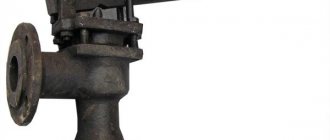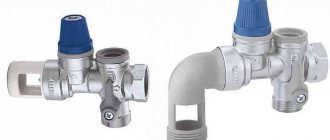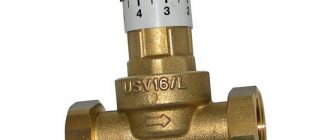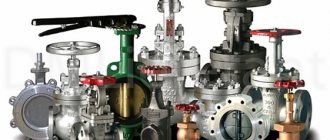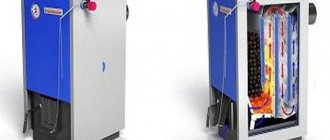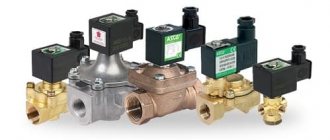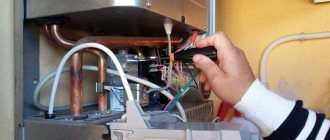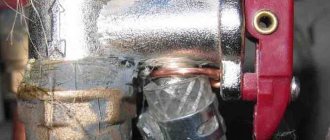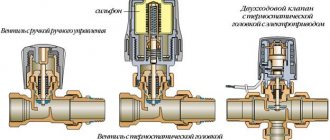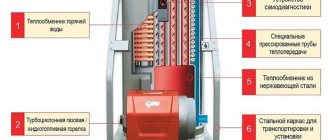Overheating of the coolant leads to its strong expansion, especially if the temperature has reached the boiling point. When the coolant expands, the pressure in the system rises, which can lead to serious consequences: from slight leakage of connections or failure of heating system components, to rupture of lines in inaccessible places (walls or under floor screed).
A well-known way to prevent the destruction of a heating system due to high pressure is a safety relief valve. In the article we will look in detail at its design and operating principle, define the criteria for choosing a mechanism, the installation algorithm in the heating system, as well as actions in a situation if the pressure relief valve has leaked.
Purpose of a safety valve in a heating system
Adjustable spring safety valve.
Most often used in individual heating systems. An increase in the temperature of the coolant in the heating water circuit leads to an increase in the pressure exerted on the walls of the system. Particularly critical are temperatures above 90-95°C, when water begins to boil, releasing steam. The pressure in the system increases exponentially. If modern pipes and radiators are designed, as a rule, for a pressure of 6-9 bar or more, then the most vulnerable point of the system is the boiler heat exchangers, which in modern models can withstand pressures of up to 3 bar, and in older models even 2 bar.
Subsequently, not just a heat exchanger leak may occur, but also a short circuit or a serious flood due to leakage of large volumes of coolant.
The safety valve ensures the automatic release of steam or coolant, freeing up space in the system for expansion due to heating, which prevents the pressure inside the water circuit from reaching critical values. After the pressure is released, the valve also closes automatically. The valve is inserted into the pipeline near the boiler itself, often a pressure gauge and an automatic air vent are also installed with it; together this complex is called a safety group.
The principle of preventing critical pressure levels in the heating system using a safety valve.
If modern models of gas and electric boilers, thanks to advanced automation, are able to prevent overheating, at least by simply turning off the burners in a timely manner, then for solid fuel boilers the installation of a safety valve is mandatory. Even after closing the damper, the heat exchanger in the solid fuel boiler continues to receive heat for some time. It is precisely because of the inertia of the heat generator that serious overheating can occur.
A relief valve is also mandatory for steam boilers (usually used for industrial purposes). However, we recommend installing a safety valve into the heating system with any boiler, including gas, installing the valve as part of the safety group.
Please note that for large volumes of the heating system (for example, designed to heat a house over 500-600 m2), it is recommended to install 2 safety valves on each boiler - a working one and a control one.
How to choose a valve for a heating boiler
When choosing a safety valve for heating, we are guided by the following considerations:
- The determining factor for selecting a safety valve is its response pressure. The usual standard for household appliances used in the heating system, according to calculations, is 3 bar. This indicator is due to the fact that in most individual closed circuits with radiators using circulation pumps, coolant is transported with a standard pressure of 1.5 bar. Its fluctuations when heated to the highest temperatures can reach 2.5 bar, and a limit value of more than 3 bar indicates overheating of the coolant and can become critical for polymer pipelines (the boiler can withstand significantly higher hydraulic loads).
- Among the models on the market, there are a lot of products from China from little-known brands. The Russian-Italian product Valtex, valves from the Italian boiler manufacturer Baxi, have a good price-quality ratio. Many well-known suppliers of electric boilers with the brands Vailant, Ariston, Baksi additionally produce related equipment, which includes safety valves.
- From the point of view of cost, ease of installation and functionality, it is best to purchase a security group. The unit additionally includes a pressure gauge (allows you to control the setup process and pressure in the system) and an automatic valve for bleeding air in the circuit.
Note: Some manufacturers (Valtex) make the handle color of non-adjustable safety valves red, yellow and black, thereby indicating the maximum permissible pressure parameters (for example, a black handle is 1.5 bar, a red handle is 3 bar, and a yellow handle is 6 bar) .
Safety valve installation diagram
Design and principle of operation depending on the type
Lever-load
Lever safety valves are used exclusively in industrial systems and are designed for heavy loads and pipeline diameters over 200 mm.
A weight hung on the lever exerts pressure on the rod. When the force exerted by the pressure in the system on one side exceeds the force exerted by the load on the other side, the rod opens, releasing coolant or steam. As soon as the pressure force inside the system becomes insufficient (it does not reach a critical point), the rod, under the weight of the load on the lever, blocks the system.
Sectional view of a lever-weight relief valve.
Thus, the critical pressure at which it is necessary to release is regulated by the length of the lever and the weight on it.
Spring
A more modern and cheaper option is the spring safety valve. It is not inferior in efficiency to a lever-load type, is reliable and has compact dimensions, therefore it is widely used in individual heating systems of private houses.
A spring relief valve works on the same principle, only instead of a load, a spring acts on the rod:
- from the inside, a flow of water or steam exerts pressure on the valve of the device;
- on the other side there is a spool pressed by a rod, which is acted upon by a spring;
- the pressure in the system exceeds the clamping force of the spring, the spool rod rises up, and depressurization occurs;
- coolant or steam exits through the outlet pipe;
- the pressure inside the system decreases and becomes lower than the pressing force of the spring, which closes the shutter again, returning the mechanism to its original position.
The operating principle of a spring safety valve designed for an individual heating system.
There are both valves designed for a specific pressure (for example, 3, 6 or 8 bar) and adjustable valves, the critical pressure for relief is set during installation. They can also be open or closed. The first ones discharge water or steam into the external environment, closed valves - into the pipeline connected to them.
Thermal relief valves
Spring-loaded safety valves are also imperfect. In addition to the fact that they work exclusively in closed systems (since boiling of the coolant in a system with an open expansion tank can occur without increasing pressure), spring mechanisms are triggered when the temperature of the coolant has already exceeded a significant level - over 95-100 ° C.
The most effective, but extremely expensive, is the thermal relief valve, which responds to an increase in the temperature of the coolant, and not the pressure in the system. The principle of operation is the same membrane, which is controlled by a spring, but it is driven not by the pressure of the water flow, but by a heat-sensitive liquid that expands significantly when heated by the coolant.
Expansion tank
Indirect heating boilers with an expansion tank
First, let's find out what it is. This is a small container that is built into the heating system and filled with air. It is designed to relieve the pressure of the coolant when it expands when heated.
There are two main systems that are directly connected to the expansion tank - open and closed. An open system is used if the heating fluid circulates naturally. That is, there is direct contact of hot water with air. The contact point is the expansion tank.
In this case, the expansion tank performs two functions at once:
- Hides the expanding volume of heated coolant.
- Allows you to remove air that accumulates in the heating system. That is why in an open scheme all highways are made at a slight angle.
The closed system is characterized by complete sealing of connections. The tank in this case is no exception. It works for its intended purpose, that is, it holds an increasing volume of hot water. What will happen if the pressure strength of the tank suddenly exceeds the maximum? The system will go from closed to open, that is, a rupture will occur somewhere. This could be a pipe or the same tank.
Both designs have very serious differences. For example, an expansion tank in an open heating system is a container with a lid. But the latter plays the role of a cover from debris and in no way provides sealing. In addition, this design does not prevent the coolant from evaporating, so it is added periodically. The closed version is a sealed container with a membrane inside. It is this that creates a barrier that prevents oxygen from entering the heating system of a private home.
As you can see, selecting an expansion tank is not as complicated as it might seem at first glance. It is important to consider the type of heating system and the volume of coolant. After all, it is believed that the volume of the expansion tank should be about 10% of the total coolant volume.
Safety relief valve selection criteria
Clamping mechanism
Lever-load safety valves are designed for heavy loads and a pipe diameter of at least 200 mm, therefore they are used in industrial heating systems.
For individual heating of a private house, it is better to purchase a device with a spring mechanism; this is a standard, reliable and frequently used type of relief valve.
If you are on a budget, we recommend purchasing a more efficient thermal relief valve, which will prevent the problem before the pressure in the heating system seriously increases.
Lifting height
Pressure relief valves have different valve lift heights:
Low-lift model PS-350.
Low-lift . The height of the shutter in low-lift valves does not exceed 1/20 of the seat diameter. They have a relatively low throughput and a simple design. Used in lines with liquid coolant. As a rule, low-lift safety valves are sufficient for a heating system with a water circuit with a power of up to 40-43 kW. To prevent an accident in such systems, it is necessary to discharge a small volume of coolant.- Full lift . The height of the valve in full-lift valves is greater than or equal to the diameter of the seat. As a rule, these are lever-load mechanisms, more expensive and complex in design. Full-lift valves have a high capacity and can be installed on lines in which gases, steam or compressed air circulate.
Full lift model PN 16.
Mechanism response speed
Based on response speed, safety valves are divided into proportional and on-off.
In heating systems of a private home, it is better to use proportional valves; again, they are sufficient for most systems. The shutter cover of such devices opens gradually, in proportion to the increase in pressure in the line, and accordingly, the volume of coolant discharged increases proportionally. Such valves do not self-oscillate, they maintain the correct pressure level and are cheaper.
Two-position safety valves are distinguished by instantaneous detonation and full opening of the valve. This mechanism allows you to quickly release large volumes of coolant, but creates the risk of water hammer: due to the rapid release of a large amount of coolant liquid, the pressure in the line significantly decreases, after which the valve closes sharply. Therefore, it is recommended to install two-position safety valves on lines with a compressible medium (air, gas, steam).
Diameter
The diameter of the pressure relief valve in the heating system should not be less than the connector of the supply pipe. Otherwise, the constant hydraulic pressure will interfere with the operation of the mechanism.
Manufacturer
Since safety valves have a fairly simple design, and modern models are in most cases made of brass using the same technology, there are no critical differences between valves from different manufacturers.
The difference between some is higher quality processing, inspection and testing of devices and a guarantee of a long service life without leaks - from 15 years. There are manufacturers whose safety valves we can recommend above all: VALTEC , WATTS , Protherm .
Varieties
Existing types of valves are capable of working with boiler equipment from leading foreign (Vaillant, Baxi, Ariston, Navien, Viessmann) and domestic (Nevalux) manufacturers using gas, liquid and solid fuels in situations where automatic control of the system operation due to the type of fuel is difficult or broken when the automation fails. Depending on their design and operating principle, safety valves are divided into the following groups:
- According to the purpose of the equipment in which they are installed:
- For heating boilers that have the above design, they are often supplied on fittings in the form of a tee, into which a pressure gauge is additionally installed to check the pressure and a venting valve.
- For hot water boilers, the design includes a flag for draining water.
- Tanks and pressure vessels.
- Pressure pipelines.
- According to the operating principle of the clamping mechanism:
- From a spring, the clamping force of which is regulated by an external or internal nut (its operation is discussed above).
- Lever-load type, used in industrial heating systems designed to discharge large volumes of water; their response threshold can be adjusted by hanging weights. They are suspended on a handle connected to the shut-off valve using a lever principle.
Lever-load modification device
- Locking mechanism speeds:
- Proportional (low-lift spring) - the sealed lock rises in proportion to the pressure and is linearly related to its increase, while the drain hole gradually opens and closes in the same way with a decrease in the volume of coolant. The advantage of the design is the absence of water hammer under various modes of movement of the shut-off valve.
- Two-position (full-lift lever-load) - operate in open-closed positions. When the pressure exceeds the response threshold, the outlet hole opens completely and the excess coolant volume is released. After the pressure in the system is normalized, the outlet is completely blocked; the main drawback of the design is the presence of water hammer.
- By adjustment:
- Non-adjustable (with caps of different colors).
- Adjustable screw parts.
- According to the design of the spring compression adjusting elements:
- An internal washer, the operating principle of which was discussed above.
- External screw, nut, models are used in domestic and communal heating systems with large volumes of coolant.
- Using a handle, a similar adjustment system is used in flanged industrial valves; when the handle is fully raised, it is possible to perform a one-time release of water.
Designs of various models of drain valves
Installing the device into the system
Schematic illustration of a boiler piping using a pressure relief valve.
Some boilers, usually wall-mounted, already have emergency valves installed by the manufacturer. If it is not there, a safety valve is installed on the boiler supply line in compliance with all the requirements described below:
- location on the supply pipeline – 200-300 mm from the boiler;
- in systems with natural circulation, emergency valves are installed at the highest point;
- For tightness, it is important to seal the threads of the fittings with tow or silicone (but not with FUM tape, which cannot withstand temperatures above 70-80 degrees without deformation);
- the valve itself must be positioned vertically (with the plastic handle up) so that an air gap is maintained under the spool; with this installation, the mechanism has the longest service life;
- It is advisable to install a pressure gauge in front of the valve (if it is not part of the safety group);
- there should be no check valves, gate valves or taps on the line between the boiler heat exchanger and the discharge valves;
- To prevent the coolant from dripping onto the floor when the valve ruptures, it is necessary to put a drain pipe leading to the sewer or return line onto the valve;
- when venting to the sewer, it is important to make a connection that involves breaking the stream (for example, through a funnel and a water seal). Thus, the system will work even if the drainage pipeline is clogged and will rid the boiler room of coolant odors.
We also recommend installing shut-off valves after the blast valve. The thing is that after 5-8 operations, the valve spring often does not work correctly and the mechanism requires replacement (fortunately, the cost of the fittings is low). However, the valve can be removed and replaced only by draining the coolant and reducing the pressure in the system to atmospheric pressure. The above-mentioned shut-off valves will help you get by with draining the coolant only from the boiler, and not from the entire system.
How to choose a water softener for a gas boiler and extend its service life
Adjusting the mechanism for proper operation
The safety valve is adjusted after completion of installation work and complete flushing of the system. Spring devices can be adjusted by rotating the adjusting knob (colored plastic cap), the rotation compresses or decompresses the spring that puts pressure on the spool. In lever-load trucks, this is done by hanging a load on the lever.
It is necessary to set the set pressure, full opening and closing:
- The setting pressure should be set slightly higher than the maximum operating pressure of the boiler.
- The full opening pressure should not exceed the maximum permissible standards of the most vulnerable element of the system, usually the boiler heat exchanger, designed for 3 or 2 bar, and in some Russian models even 1.5 bar.
- The valve closing pressure must be set slightly higher than the minimum allowable for system operation.
It is recommended to check the serviceability of emergency valves at least once every 6 months.
How to install
When installing safety drain fittings, observe the following rules:
- Typically, a pressure relief valve in a heating system is installed in a household circuit in a single copy. Its main placement points are directly above the electric, solid fuel, gas boiler on its outlet pipe or nearby in a horizontal pipeline. If this is not possible for technical reasons, the main condition for correct installation is installation in the supply line up to the first shut-off valve.
- The side outlet pipe is usually connected to a sewer or drainage system; if this is technically difficult or the volume of coolant in the circuit is low, you can use a flexible line, which is lowered into a container of suitable volume.
- The liquid must be drained with a stream breaking through a funnel or hydraulic valve to ensure the system is operational when the sewer is clogged.
- When installing in a pipeline, use a tee with a bottom outlet of a suitable diameter, its standard value is 1/2, 3/4, 1 and 2 inches. The diameter of the pipeline supplying the valve should not be less than that of the system.
Safety valve groups - types and price
What to do if water drips through the relief valve
The nature of the problem depends on whether the water from the safety valve is dripping or flowing in a stream.
If the coolant is dripping, this indicates normal operation of the emergency valves, but the heating system is operating at the limit, since the temperature in the coolant in it is increased and the pressure exceeds the norm. It’s easy to check whether the drops are the natural operation of the mechanism - just lower the operating temperature, allowing the coolant to cool. If the water drainage stops, then everything is in order, you just need to prevent further reheating.
A mechanism clogged due to contaminated coolant. Particles of sand and dirt prevent the rod from completely closing, which causes leakage.
If the drops do not stop or the coolant is discharged in large quantities, in a stream, this indicates a malfunction of the safety valve: the spring, rubber or silicone seal are worn out, the fitting is clogged, as a result of which it does not fit tightly. It is not recommended to disassemble the mechanism yourself; in this case, it is necessary to replace the relief valve (issue price 400-900 rubles).
Safety valve installation features
Heating diagram with installed safety valve
Professional installation of a safety valve in a heating system involves taking into account not only its characteristics, but also the operation of the expansion tank. As soon as the latter is unable to expand the internal volume of the pipes, the bypass valve must operate and remove excess water from the pipes.
According to the rules, the relief safety valve for the heating system must be installed immediately after the boiler outlet pipe (in the diagram these are elements 3 and 4). The optimal distance between them is 20-30 cm. For visual control, a pressure gauge is mounted in front of it. Based on its readings, you can determine the current state of the system.
There are certain rules for installing a safety valve in a heating system:
- Shut-off equipment – valves, taps, etc. – must not be installed in front of the device and the boiler;
- To remove excess water, a drain pipe is installed at the outlet pipe of a correctly selected heating safety valve. It can be connected to a return or sewer pipe;
- In a closed gravity system, the heating safety valve is installed at the highest point.
In addition, you need to periodically check the condition of the mechanism. Spring models are characterized by “sticking” of the plate to the walls of the housing. This increases the maximum opening pressure of the safety valve in the heating system. As a result, if the permissible pressure value is exceeded, the device will not work.
To a greater extent, the latter relates to the operating conditions of the safety valve for heating rather than to the principle of its operation. However, without this, even with ideal installation, the likelihood of incorrect operation of the device increases.
If the number of emergency descents was 7-8 times, experts recommend replacing the valve. This is due to natural wear and tear on the spring and plate.
What should be taken into account when selecting a safety valve for an autonomous heating system? Compliance of its technical characteristics with operational ones. It is also important to connect it to the pipe correctly. For this, it is best to use traditional pipe tow. The FUM tape may not withstand the effects of temperature, resulting in a leak.
To better understand the operating principle of the safety valve, it is recommended to watch a video about the design and operation of the spring model:
Price
The price of the mechanism depends on its type, characteristics, materials and workmanship, quality of processing and manufacturer's markup.
| Model | Allowable pressure, bar | Cost, rub. |
| Spring | ||
| WATTS SVH 3/4″x1″ | 3 | 690 |
| VALTEC ½ (VT.0490.IG.0460) | 3 | 550 |
| VALTEC ½ (VT.1831.N) – adjustable | 12 | 915 |
| Lever-load | ||
| Pregran KPP096-01 Du15 | 16 | 19 200 |
| 17s28nzh Du50 Ru10-16 | 16 | 12 000 |
| Thermal relief valves | ||
| Watts STS 20 art. 02.32.120 | — | 4 900 |
| Protherm Caleffi 544 – 1/2″ | — | 12 000 |
InstructionsBoiler room equipmentSafety fittings
Types of safety valve:
- Clutch fuses are made of brass. This type is direct-flow, that is, it opens by pressure. This is a cheap option, but quite reliable. And it has a simple design: threads on both sides, and a rod with a gasket.
- Brass fuse with a more complex design. Such a valve should be installed in the heating system after the circulation pump. The spring and rod in this design are made of stainless steel. This safety device can withstand temperatures up to 1200C.
- Check valves are a type of safety device that should prevent backflow of coolant in the heating system if the pressure drops there.
Installation Features
A device for releasing excess water pressure is installed taking into account the presence of an expansion tank in the heating system - the valve is activated after the volume of the membrane tank is exhausted.
Boiler safety group
The safety device is mounted on a pipeline connected to the boiler outlet pipe, at a distance of 20-30 cm from it.
In this case, the following conditions are met
:
- if the valve is installed separately and not as part of a safety group, a pressure gauge is installed in front of it to control the pressure;
- It is prohibited to install shut-off valves (taps, valves) between the boiler and the safety valve, as well as a circulation pump (it is not designed for pumping a mixture of water and steam);
- a drain pipe is attached to the outlet pipe of the valve, which drains excess coolant into the return pipe or into the sewer;
- in a system with natural coolant circulation, the emergency valve is installed at the highest possible point.
The emergency device installed on the heating boiler must be changed after 7-8 operations, since the valve loses its tightness due to wear of the plate and spring.
